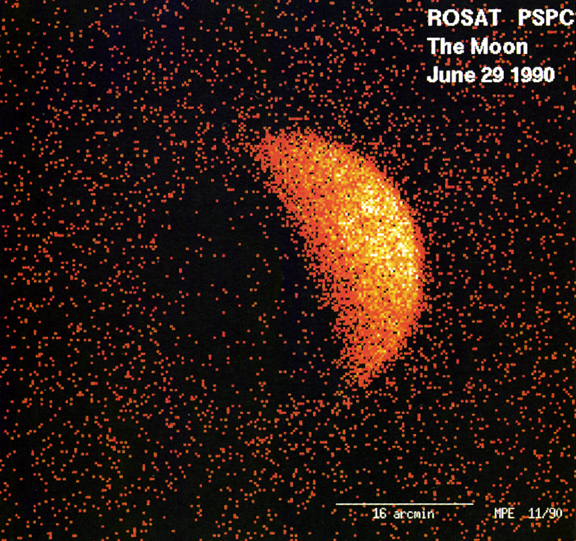
 Credit: MPE
Credit: MPE
Good Night, Moon
The search for X-ray emission from the moon is historically important. The attempt to detect solar X-rays reflected off the moon was the driving force behind the MIT/ASE rocket flight on June 12, 1962. This experiment failed to detect the moon, but during its two minute flight discovered Sco X-1 and the cosmic X-ray background and ushered in the age of X-ray astronomy, the study of the high-energy Universe beyond the solar system. The image above is an X-ray image of the moon obtained by the ROSAT X-ray observatory nearly 30 years after the initial MIT/ASE attempt. Astronauts walking on the bright side of the moon are also exposed to this X-ray radiation, but not to fear - the amount of exposure is so small that it does not present any risk to moonwalkers. ROSAT also revealed faint X-ray emission from the dark side of the moon, as you can see in the image above. The origin of this emission remained a mystery for many years. This mystery was solved by observations from the Chandra X-ray Observatory, which showed that the X-rays from the dark side of the moon are produced by the earth's "geocorona", a region of ionized plasma which surrounds the earth, extending from about 15 to 100 earth radii. The ROSAT image of the moon was equally important to show that the moon shadows the cosmic X-ray background, indicating that most of this diffuse X-ray glow seen from earth originates from beyond the moon's orbit.
Published: July 22, 2019
<
HEA Dictionary ● Archive
● Search HEAPOW
● Other Languages
● HEAPOW on Facebook
● Download all Images
● Education ● HEAD
>

Each week the HEASARC
brings you new, exciting and beautiful images from X-ray and Gamma ray
astronomy. Check back each week and be sure to check out the HEAPOW archive!
Page Author: Dr. Michael F. Corcoran
Last modified Tuesday, 27-Feb-2024 10:08:21 EST


